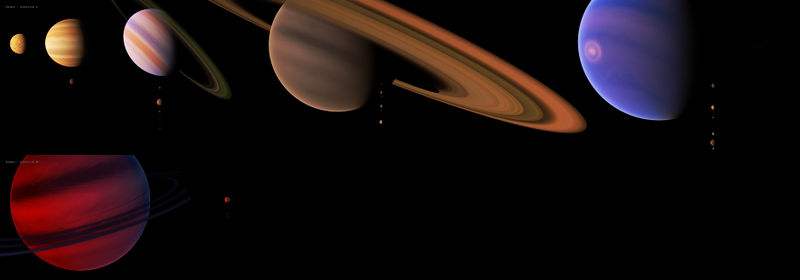Thebes
Link to Systembodies Raw Viwer
Right Ascension: 5h 54m 58s
Declination: -64° 26'
Distance: 250.18 parsecs (817 light years)
Thebes, originally designated UNTJS 007, is a trinary solar system accessed from the Hakahaka crossroads.
Thebes is the place of the first encounter with The Mind in the beginning of 2036. The system consists mostly of gas giants and notably lacks any naturally habitable planets, leading to a hypothesis that it cannot the The Mind's home system.
Three of the gas giants are so massive that small wormholes have formed at their Lagrange points, allowing easy jumps in between the A and BC subsystems. Even though Thebes B orbits Thebes A at the distance of 21 billion km, a Lagrange jump shortens this distance to a mere 1 billion.

Geography
Thebes is a trinary system. The primary component, Thebes-A, is a dim K8-class orange dwarf star, just over half the mass of Sol and barely 11% as luminous. It is orbited by Thebes-B, a planetless white dwarf half the mass of the sun and only 0.07% as bright. Thebes-B has its own companion, Thebes-C, a T-class brown dwarf about 30 times the mass of Jupiter.
Thebes-A has a modest planetary system consisting of five planets, four of which are gas giants.
- Thebes-A I, the innermost planet, is a terrestrial body 50% larger than Earth and six times more massive, orbiting a scant 23.5m km from the primary. This gives it a surface gravity of a crushing 2.6 gs, which renders it unsuitable for long-term human habitation. The planet has a thick CO2/NO2 atmosphere with a pressure of over 119 atmospheres. The surface appears geologically active, but there is no sign of a water-based hydrosphere.
- Thebes-A IV is a modestly sized ice giant somewhat smaller than Neptune. The planet orbits at 166m km from the primary, well beyond the habitable zone of such a dim star. It has a single atmosphereless moon about 40% the size of Earth which holds some potential for habitability.
- Thebes-A V is a much smaller ice giant, only about three times more massive than Earth, orbiting 363m km from the primary. Despite its small size (rather near to the minimum size for a gas giant with its given insolation), it has an extensive moon system, with seventeen bodies greater than 20 km in diameter. One moon, (M7) has a thin nitrogen atmosphere as well as frozen carbon dioxide deposits on the surface. With a diameter about half that of Earth and a surface gravity of 0.32 gs, it is the only moon of Thebes-A V capable of supporting human habitation. Its low surface temperatures are a major obstacle to such habitation.
- Thebes-A VI is a huge gas giant, twice the mass of Jupiter. It orbits 741m km from the primary, surrounded by fifteen moons larger than 20 km in diameter. One of the moons (M14) has surface gravity tolerable to humans (0.18 g), but the lack of atmosphere and frigid environment make it a long shot at colonization. However, like other super-jovian planets discovered by UNSA, this one too contains a gravitational anomaly at one of its Lagrange points that could theoretically be used for an intra-system jump. Unlike other systems, Thebes actually contains a second super-jovian (two others, actually), providing a destination terminus for the Thebes-A VI Lagrange Point.
- Thebes-A VII is a gas giant about two-thirds the mass of Jupiter, with a semi-major axis of 1.50b km. It, too, possesses a large moon system, with over 23 objects discovered with diameters greater than 20 km. Three of the bodies have surface gravities suitable for humans (M2: 0.19 g, M10: 0.21 g, and M21: 0.16 g). None of the three have any atmosphere, and all are subject to temperatures below -222°C. Thebes-A VII is actually large enough to cause the same sort of space warping effect as Thebes-A VI, meaning its trailing Lagrange Point can be used for intra-system jumps.
- The Thebes inner system is also home to one comet, with an aphelion just inside the orbit of Thebes-A VII.
The brown dwarf Thebes-C has two planetary companions.
- The inner planet Thebes-C I is another enormous gas giant, even larger than the one circling Thebes-A (Thebes-C is only 13 times more massive than Thebes-C I). It whirls around Thebes-C every 73 days, only 15.1m km from the surface of the brown dwarf. Its gravitational wake causes a singularity effect linking its trailing Lagrange Point with the trailing Lagrange Points of Thebes-A VI and Thebes-A VII, providing a 'shortcut' for moving between the inner and outer system.
- Thebes-C II is a frozen terrestrial planet 40% the size of Earth orbiting Thebes-C at a distance of 44m km. It has a trace atmosphere and is technically habitable, but as with many of the worlds in Thebes, it is too cold to be a decent terraforming prospect. Thebes-C II has five moons with diameters between 100 and 1250 km, none of which have enough surface gravity to hold on to an atmosphere, much less be useful for human colonization.
The outermost reaches of Thebes are populated by a number of Kuiper Belt Objects with semi-major axes between 156 AU and 1170 AU, about 80 of which are larger than 20 km in diameter. The largest is roughly 800 km across. There is also a single notable long-period comet with an aphelion of 123 AU.
